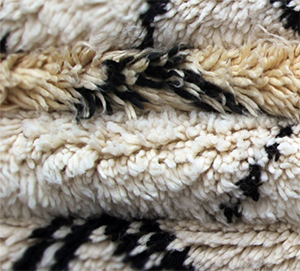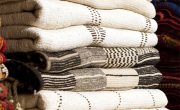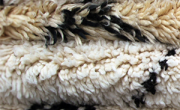Moroccan Berber & Beni Ourain Rugs: Ancient Tradition Meets Modern Elegance
 Considered the most prestigious of all Moroccan rugs, Beni Ourain carpets are a unique piece of Berber culture with a long history and a stylish addition to modern homes. From women who have handed the rug-weaving technique down from generation to generation, every Beni Ourain – or Moroccan Berber – rug tells a personal and one-of-a-kind story, and is therefore 100% unique. The resulting masterpiece can therefore be proudly displayed by any amateur collector or home-owner as a traditional and timeless treasure.
Considered the most prestigious of all Moroccan rugs, Beni Ourain carpets are a unique piece of Berber culture with a long history and a stylish addition to modern homes. From women who have handed the rug-weaving technique down from generation to generation, every Beni Ourain – or Moroccan Berber – rug tells a personal and one-of-a-kind story, and is therefore 100% unique. The resulting masterpiece can therefore be proudly displayed by any amateur collector or home-owner as a traditional and timeless treasure.
History
Beni Ourain is the name of a confederation of seventeen Berber tribes all indigenous to the Northeastern mountains of Morocco. These tribes spend the summer with their herds on the heights of the range and come back down to the plains with the first snowfall. This provides their goats and sheep with a rich and abundant food throughout the year, resulting in the high quality wool used to produce the distinctive rugs. Despite this migration, winter in the Moroccan Atlas Mountains is difficult, and the Beni Ourain tribes, who lived in traditional tents, originally used these thick wool rugs as bedding and blankets to insulate themselves from the hostile environment. Tho now prized for their tremendous aesthetic value, the origin of these rugs was practical, not decorative.
Design
The cultural influences apparent in the designs of Beni Ourain rugs can be traced back to the dawn of time. The common diamond motif, for example, has existed since Neolithic times while the Berber and African cultural symbols combine with the ancestral signs of caravans of the Sahara and Sudan to produce the distinctive rug designs. The irregular and abstract patterns, symbols, stripes, diamonds and other geometric graphics are woven and knotted with colored materials, tainted with vegetable dye or threads of recycled colored cloth, and worked masterfully into an ivory or cream virgin wool background.
Berber women weave with their fingers – without drawings, premeditation, or defined designs – to tell a unique story and create an expression of universal beauty. The weavers incorporate ancestral tribal signs to express common themes such as their wedding, pregnancy, childbirth, motherhood and daily, rural life. The poverty of the materials used and the mundane subject matter contrast brilliantly with the limitless sensitivity of the emotions expressed and the richness of the final composition.
Modern Elegance
Although conceived for warmth as opposed to artwork, the honesty of the bright colors and elegance of the abstract lyrical movements have made Beni Ourain rugs increasingly popular. Exhibits featured in the Museum of Early Art in Paris have added prestige to this traditional tribal art and inspired artists such as Matisse, Paul Klee and Le Corbusier. The strong, bold, and sensitive characteristics of the Berber carpets can also be seen in works by Kandinsky, Mondrian, Pollock, and other abstract artists. These timeless and inspiring works of art are now sold internationally as chic, elegant, and fashionable rugs.
A blend of traditional and contemporary styling, the natural white and ivory tones contrast with the darker intertwined wool to create simple luxury and a pleasing charm. The combined modernist taste and minimalist linearity result in a truly one-of-a-kind decoration that pairs perfectly with both contemporary and traditional designs. Their timeless quirkiness additionally adds value to furniture whether it is antique wood, leather, or a custom-designed piece. With the value and class they bring to a home, it is no wonder that Moroccan Berber carpets have gained such international attention.
Conclusion
For the sake of tradition and art, the weavers continue creating their masterpieces, and the rest of the world continues to benefit from their brilliance and beauty. The women who have been weaving these rugs for generations combine ancestral symbolism with real life experiences portrayed in simple yet intriguing patterns and designs. Their creativity, based on a wide repertoire of techniques, patterns, and ancient knowledge, has been inspiring artists for decades and grown into an elegant fashion statement in the modern world. Finally, it is important note is that buying fair trade rugs from these Berber artists gives them a source of personal income, allowing them to continue producing these masterpieces, beautifying the world, and preserving their heritage and identity. To learn how to take care of your berber rug click here.







